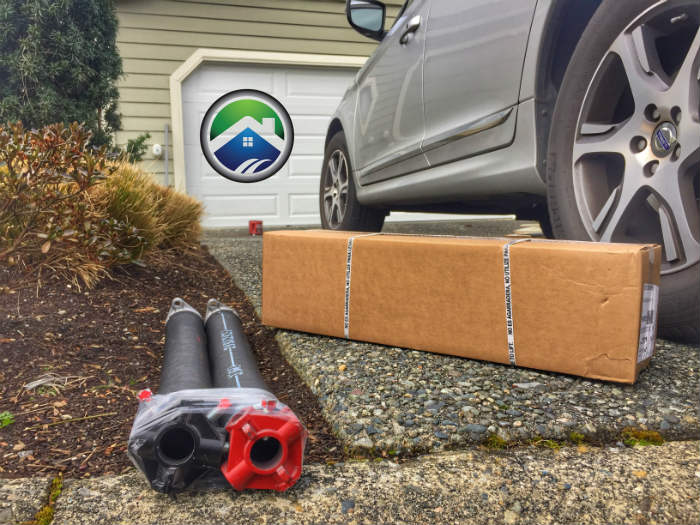There are some homeowners who have researched the benefits of converting their one garage door spring configuration to two springs. It should note that the problem with their decision to do it themselves based on a couple of misconceptions. First of all, they may initially be unclear as to why they would want to convert their garage door. Secondly, they may also see this type of conversion as a very difficult DIY undertaking. Figuring out how to do this job yourself is something that can be done with the help of online assistance, though.
However, once they’ve read up on how to do this project, most are surprised to find that it’s not all that tough to add the second spring. As a matter of fact, you don’t even need to obtain any special tools for this project! You’ll also discover that even though you’re winding two springs, rather than only one, each of the two springs is only ½ as strong as winding a single spring. So that means there isn’t any extra work, to begin.
How Your Garage Door Springs Work
When you go to purchase a couple (pair) of garage door torsion springs, you get a left and a right spring. The direction that the door springs wrapped will show you the “wind” of the spring. At this point, you need to know that, when taking a look at the inside of your garage, the left spring is attached to the right and vice versa for the other spring. You’ll end up winding on both springs since one is a mirror image of the other. Some folks may believe that one of the springs raises the garage door up, while the other spring does the opposite. But that’s not true. They work together, so the weight of your garage door is balanced when it raises and lowers.
The Benefits of Using Two Springs, Rather Than Just One
As previously mentioned, there are some benefits to being gained from using two springs instead of just a single spring. These benefits include both using and installing the springs, themselves. For example:
Half The Weight (When Installing)
When you’re using two springs, you’re just using half the weight of the door for each spring as opposed to all of the door’s weight on a single spring. That means that you can take a break midway through your installation project. As you can see, this DIY is not looking so bad!
Avoiding The Extra Expense Of Replacement
You should know that many original new garage door installers like to use just one spring to save money. However, doing this only saves about $2 – $3. Also, by installing just one spring, they know that there is the possibility of making additional money, in a few years, when the single door spring wears out. Not so great!
Preventing Additional Garage Door Damage
If you’re talking about using the older type of configuration that uses flat end bearing plates, you’re talking about plates that are usually not reinforced. That can cause a bend in the supporting angle if the cable drum is forced into the end bearing plate. When this happens, the drum will scrape, and the cable ends up peeling off the drums. If you find yourself using the older-style plates, don’t feel too bad! You might fix the situation by preventing that end bearing plate scraping by bracing the plate to the header with wood or angle iron. However, if you’re using a single spring (0.273 or greater), that extra pull can wear out the bearing. You should take a look and see if a second spring will fit on the shaft. If so, investing in a second spring can save the cost of a bearing replacement. That minimizes damage to your bearing plate, bearing, cable drum and cable by pulling the shaft in the opposite direction, thus canceling out the forces placed on these parts.
Double-Car Garage Doors
You’ll also see situations in which a manufacturer has decided to cut costs by only using a single spring on a double-car door. On a 16’ double-wide garage door, a significant portion of the spring will spin loose if the spring breaks near the stationary cone. With the winding cone attached to the door’s shaft, the cable will begin to experience strong pulling forces that can cause the cables to break. It can even damage the door’s top section or even the entire door if the open-up force set up too strongly! Having a second spring installed can lessen the damage to your garage door, should that first spring break.
Safety issues
You can even experience a life-threatening situation should a garage door spring break as the door is closing. That can set up a situation in which the door suddenly slams shut – even if there is an electronic “eye” that is designed to keep the door from closing when someone is standing underneath it! At the very least, the door can seriously damage upon hitting the ground. But, should this occur, you could find yourself with a lot more than a garage door replacement bill, since hospital and funeral expenses can be significantly greater!
The Life Of Your Garage Door Springs
Regarding measurement, “one cycle” is used up upon the opening and subsequent closing of your garage door. When talking about the total number of expected cycles for a garage door spring, the industry refers to this as the “cycle life” of the spring. You should know that most manufactured garage doors will have room for springs that possess longer cycle lives. By installing two springs, a homeowner can have a better range of spring cycle life. An example of this can be seen when a homeowner wants a 40,000 spring cycle life, but can only get either a 30,000 or a 60,000 cycle-rated spring. With two springs, it’s possible to buy two 40,000 cycle life springs that are cheaper than that 60,000 cycle life spring, and you’ll get more spring cycles than that 30,000 cycles life-rated spring!
As you can see, there are some benefits to installing two garage door springs, instead of having a single spring.
You can contact your Local Garage Door Professionals for more information.















[…] Reaping the Benefits of a One Garage Door Spring to Two Springs … […]